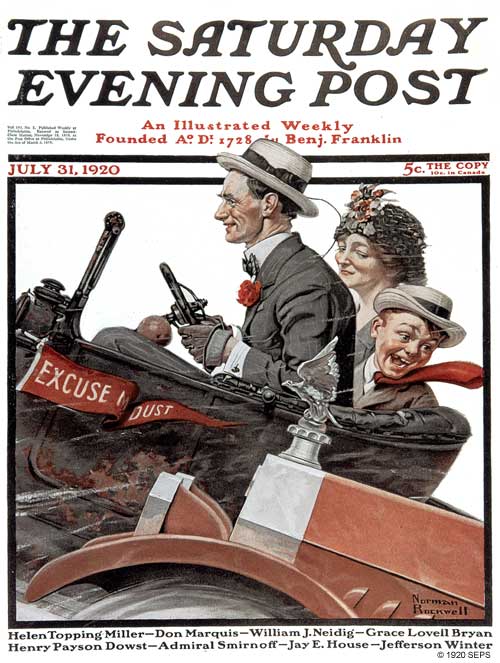
© SEPS
Norman Rockwell did Post covers from 1916 to 1963 — a remarkable 47 years. Who were the folks on his first generation of covers?
Below are some fun details about two men who transformed into new characters over and over again on the covers of the 1920s: Dave Campion and Pop Fredericks. At right, they appear together as Victorian musicians in the 1923 holiday cover, Christmas Trio. Campion is the taller man on the right, and Fredericks, left.
Dave Campion
“There was one kind of idea which I didn’t have to struggle over,” Rockwell wrote in My Life as an Illustrator, “the timely idea. In 1920 the whole country was talking about Model T Fords and Henry Ford.”
So, he created the July 1920 cover of the Campion family (below, left) in their rusty Model T, easily passing an expensive Peerless.
Dave Campion, the driver living life in the fast lane (as much as one can at 30 mph), ran a newsstand in New Rochelle, New York — where Rockwell worked and lived when this illustration was created. One can’t help but wonder what it was like for Campion to sell the latest issue of The Saturday Evening Post with himself on the cover!

Norman Rockwell
July 31, 1920
© SEPS

Norman Rockwell
April 20, 1929
© SEPS
In the top right illustration, Campion, given a slouchy hat and a mean squint, transforms from the amiable dad in 1920’s Excuse My Dust, to the long arm of the law. “Welcome to Elmville,” indeed. (The arm caught Norman Rockwell speeding through Amenia, New York, giving him the idea for this cover. “That was back in the days when towns paid their taxes with speeders’ fines, and the Amenia cop really nailed me — right along the welcome sign!”)
Pop Fredericks
Unlike Campion, who had found his calling selling periodicals and papers, Pop Fredericks was an actor who never quite made it. “Pop had been, as he told it, cheated of fame,” Rockwell wrote. Fredericks was in a play that was just gaining momentum when he was replaced by a better-known actor.
Fredericks’ acting ability allowed him to portray a wide range of personalities, making him a rugged character in one cover (below, left) and a kindly doctor in another (below, right). Like Campion in the covers above, the contrast between the two characters is significant.

Norman Rockwell
March 12, 1927
© SEPS

by Norman Rockwell
March 9, 1929
© SEPS
Though Fredericks never became a renowned actor, he achieved immortality on Post covers: as a seasick ocean voyager, a cellist, a politician, and an obliging physician (above, right) who can’t resist allaying the worries of the little mother. The Doctor and the Doll was an all-time favorite and is one of the most collectible Post covers of all time.
Become a Saturday Evening Post member and enjoy unlimited access. Subscribe now



